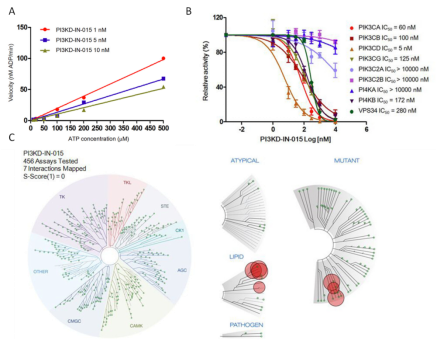The lipid kinase PI3Kδ is specifically over-expressed/aberrantly activated in a variety of B-cell malignances such as chronic lymphocytic leukemia and acute myelocytic leukemia. Till now, PI3Kδ has been extensively explored as a therapeutic target in hematologic malignancies. The CAL-101 is the first selective PI3Kδ inhibitor approved by US Food and Drug Administration (FDA) for the treatment of chronic lymphocytic leukemia, B-cell non-Hodgkin lymphoma and relapsed small lymphocytic lymphoma.
Based on the X-ray structure of PI3Kδ kinase, a study team in High Magnetic Field Laboratory, Chinese Academy of Sciences (CHMFL) designed a highly potent and selective ATP competitive PI3Kδ inhibitor, PI3KD-IN-015.
The ADP-glo biochemical assay demonstrated that the PI3KD-IN-015 inhibited PI3K with a IC50 of 5nM, meanwhile it exhibited 12~60 fold selectivity against PI3Ks and PI4Ks kinases. The selectivity profile of PI3KD-IN-015 in the kinome wide range displayed that the PI3KD-IN-015 did not target any other protein kinases except for a few lipid kinases, including isoforms and mutants of PI3K and PI4K at a concentration of 1μM.
The effects of PI3KD-IN-015 on PI3K mediated downstream signaling in various B-cell malignant cell lines showed that PI3KD- IN-015 potently inhibited the phosphorylation of Akt at both Thr308 and Ser473 sites, the downstream target of PI3K, among MOLM-13 , HT, Namalwa, MEC-1, MEC-2, and HS505T cells, with EC50 less than 1 μM.
The anti-proliferative activity against cancer cell lines showed that PI3KD-IN-015 exhibited moderate antiproliferative effects against most of the cell lines including AML, B-cell lymphoma and multiple myeloma cell lines with GI50 between 1-10 μM but did not exhibit apparent inhibitory activity against CLL cell lines. The PI3KD- IN-015 effectively suppressed the growth of 2 of 3 CLL primary cells and was effective against most of AML patient cells with GI50 less than 10 μM.
The study also reported that PI3KD-IN-015 induced apparent PARP cleavage in MOLM-13 cell, HT cell, but only weakly in MEC-1 cell within 12 hours. Similar trend was observed for the reported PI3Kδ inhibitor, CAL- 101 and pan-PI3K inhibitor GDC-0941. Both HT cells and MEC-1 cells, treatment of PI3KD-IN-015 significantly increased the production of LC3B II, which indicated that PI3KD-IN-015 can induce autophagy, probably through its activity against PI3Kδ.
The results were published in Oncotarget entitled Characterization of Selective and Potent PI3Kδ Inhibitor (PI3KD-IN-015) for B-Cell Malignances.

Selectivity and Activity of PI3KD-IN-015 (Image by LIANG Xiaofei)

PI3KD-IN-015 induces apoptosis and autophagy in B-cell related cancer cell lines (Image by LIANG Xiaofei)
LIU Qingsong, PhD
High Magnetic Field Laboratory, Chinese Academy of Sciences
Mailbox 1110, 350 Shushanhu Road, Hefei, Anhui, P. R. China, 230031
Phone:86-551-65595161
Email: qsliu97@hmfl.ac.cn
 Tel: +86-551-65591206
Tel: +86-551-65591206
 Fax: +86-551-65591270
Fax: +86-551-65591270
 Emai: zhous@hfcas.ac.cn
Emai: zhous@hfcas.ac.cn
 350 Shushanhu Road
350 Shushanhu Road